Along with the curated exhibition, the XXII Triennale is organized around twenty-one international participations, invited through official government channels under the auspices of the Bureau International des Expositions. The international participants have responded to questions and issues surrounding the concept of a “broken nature,” providing insight into alternative understandings of our relationships with the environment that we live in and shape.
For the first time, La Triennale di Milano has granted the Bee Awards–Golden, Black, and Wax Bee–which were awarded to the three most deserving entries among the international participations. The trophies were assigned, respectively, to Australia, Austria, and Russia.
ALGERIA
Toward a Return to Ancestral Heritage Values as Resources and Way of Life for an Uncertain Future.
COMMISSIONERS Ministry of Housing, Urban Planning and the City: Abdelwahid Temmar, Minister; Abdelwahid Temmar, General director Architecture and urban planning; Naima Rachedi, Director of urban planning; Rachida Djender, Director of architecture; Malik Mammeri (director of city policy); Fatima Zohra Aouali (Director of cooperation); Ministry of Culture: Azzedine Mihoubi, Minister; Ismail Oulebcir, General Secretary; Zahia Bencheikh, Director of Arts Development and Promotion; Naqwl Younsi Dahmani, Director of Prospective studies of documentation and informatics. CURATORS Naima Rachedi, Rachida Djender (architecture), Feriel Gasmi Issiakhem, Hellal Zoubir (design). TEAM Aissaoi Ryad (Scenography Design), Sabiha Mohammedi (architecture), Matari Jahel (design and photography), Meriem Elhara (Head of visual arts, the Algerian Agency for Cultural Radiation AARC). FOUNDING Ministry of Culture, Ministry of Housing Urban Planning and the City. SUPPORT Algerian Agency for Cultural Radiation AARC.
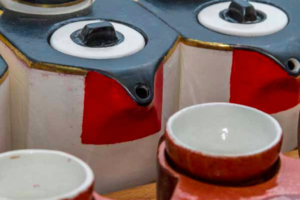 Algeria’s potential can be capitalized on by mobilizing local know-how, based on local and regional history, which has a strong identity and is promoted by quality processes. These processes should become the focus of new socioeconomic sectors aimed at strengthening “heritagization.” The public—the main actor—can become more involved in the appropriation of these resources by mobilizing their capacities, reverting to past techniques of territorial marketing, and promoting community practices, such as the use of the fougara plantation irrigation system in the southern city of Ghardaïa, and earthen architecture, evidence of several civilizations, scattered across the country. By reducing the opposition between modernity and tradition, tourism will be encouraged and therefore the mobilization necessary for sustainability can be achieved. The value system behind heritagization processes in this new vision of territorial development attempts to reduce the opposition between modernity and tradition.
Algeria’s potential can be capitalized on by mobilizing local know-how, based on local and regional history, which has a strong identity and is promoted by quality processes. These processes should become the focus of new socioeconomic sectors aimed at strengthening “heritagization.” The public—the main actor—can become more involved in the appropriation of these resources by mobilizing their capacities, reverting to past techniques of territorial marketing, and promoting community practices, such as the use of the fougara plantation irrigation system in the southern city of Ghardaïa, and earthen architecture, evidence of several civilizations, scattered across the country. By reducing the opposition between modernity and tradition, tourism will be encouraged and therefore the mobilization necessary for sustainability can be achieved. The value system behind heritagization processes in this new vision of territorial development attempts to reduce the opposition between modernity and tradition.
AUSTRALIA (Golden Bee)
Teatro della Terra Alienata (Theatre of the Alienated Land)
COMMISSIONER Faculty of Design, Architecture and Building, University of Technology Sydney. PARTICIPANTS Grandeza Studio (Amaia Sanchez-Velasco, Jorge Valiente Oriol, Gonzalo Valiente), Miguel Rodríguez- Casellas, Master’s Design Studio “Factory of Hyper-Ecologies” at the School of Architecture, University of Technology Sydney. TEAM Shoufay Derz, Charles Curtin, Isaac Harrisson. FUNDING University of Technology Sydney (UTS). PRINCIPAL PARTNER HDR.
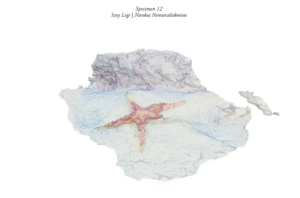 Recent massive coral bleaching events rendered visible the plausible death of the Great Barrier Reef. In response, the Australian government partially outsourced the preservation of the earth’s largest living structure to a nonprofit supported by major minings, banking, insurance, airline, and fossil-fuel corporations. To address the impact of such a hegemonic economic system of oversight, the United Nations Intergovernmental Panel on Climate Change took control of the land-water enclave and the algorithmic technologies previously deployed on site. Teatro della Terra Alienata stages a fictional scenario of territorial secession, proposing a reappropriation, expansion, and concatenation of existing technologies of surveillance and ecological management embedded in the life cycles of the reef. Inspired by Laboria Cuboniks’s Xenofeminist manifesto, these technologies become the poetic arsenal for a rational, universalist project of emancipation. The pavilion consolidates two years of research and pedagogical projects that engage with the crisis of the political imagination as a form of institutional critique.
Recent massive coral bleaching events rendered visible the plausible death of the Great Barrier Reef. In response, the Australian government partially outsourced the preservation of the earth’s largest living structure to a nonprofit supported by major minings, banking, insurance, airline, and fossil-fuel corporations. To address the impact of such a hegemonic economic system of oversight, the United Nations Intergovernmental Panel on Climate Change took control of the land-water enclave and the algorithmic technologies previously deployed on site. Teatro della Terra Alienata stages a fictional scenario of territorial secession, proposing a reappropriation, expansion, and concatenation of existing technologies of surveillance and ecological management embedded in the life cycles of the reef. Inspired by Laboria Cuboniks’s Xenofeminist manifesto, these technologies become the poetic arsenal for a rational, universalist project of emancipation. The pavilion consolidates two years of research and pedagogical projects that engage with the crisis of the political imagination as a form of institutional critique.
AUSTRIA (Black Bee)
Circular Flows: The Toilet Revolution
COMMISSIONER Christoph Thun-Hohenstein, General Director and Artistic Director, MAK – Austrian Museum of Applied Arts / Contemporary Art. CURATOR Marlies Wirth, Curator Digital Culture and Design Collection, MAK. TEAM EOOS (concept, design, and installation), Process Studio (animation and graphic design). FUNDING Federal Chancellery of Austria, MAK – Austrian Museum of Applied Arts / Contemporary Art. SUPPORT Tove Larsen (Eawag – Swiss Federal Institute of Aquatic Science and Technology), Austrian Cultural Forum Milan, LAUFEN, Zumtobel.
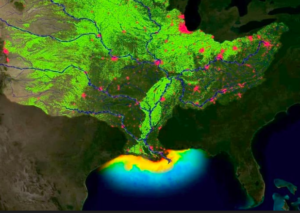 Circular Flows is a collaboration with Swiss water research institute Eawag, a pioneer in the field of urine separation. Acceptance of toilet systems based on separation of waste materials has to date been hampered not by technological factors, but by negative user experience through inadequate design. After years of joint research, EOOS has developed a new technology for simply separating urine in a flush toilet without the user’s ever noticing. Urine Trap allows significant amounts of nitrogen and phosphorus excreted in human urine to be removed from wastewater, collected locally in tanks, and then processed to be used as fertilizer. In urban catchment areas, too much nitrogen leads to increased algae growth in river estuaries; when the algae die off, water in the coastal regions is deprived of oxygen, resulting in dead zones where no life can exist. The public remains largely ignorant of the dangers of nitrogen in wastewater and agrarian fertilizers.
Circular Flows is a collaboration with Swiss water research institute Eawag, a pioneer in the field of urine separation. Acceptance of toilet systems based on separation of waste materials has to date been hampered not by technological factors, but by negative user experience through inadequate design. After years of joint research, EOOS has developed a new technology for simply separating urine in a flush toilet without the user’s ever noticing. Urine Trap allows significant amounts of nitrogen and phosphorus excreted in human urine to be removed from wastewater, collected locally in tanks, and then processed to be used as fertilizer. In urban catchment areas, too much nitrogen leads to increased algae growth in river estuaries; when the algae die off, water in the coastal regions is deprived of oxygen, resulting in dead zones where no life can exist. The public remains largely ignorant of the dangers of nitrogen in wastewater and agrarian fertilizers.
CHINA
Environmental Consciousness in Design
COMMISSIONER Su Dan. curators Su Dan (chief curator), Lou Yongqi, Zhao Yang, Zhou Yanyang. TEAM Tsinghua University: Xu Weiguo, Zhou Yanyang, Xiang Fan, Zhu Shunshan, Li Haibing, Gao Yuan, Sun Chenwei, Wang Zhi, Li Ning, Si Yuyi, Zheng Jing, Jing Ke; Tongji University: Lou Yongqi, Aldo Cibic, Tiziano Cattaneo, Ni Minqing, Wu Di, Micheal Lai, Ding Junfeng, Zhang Yinan, Yu Xinan, He Wei, Zhou Hongtao, Francesca Valsecchi, Zhao Huasen, Shu Chang, Feng Kai, Xu Peng, Zhang Yuhan, Zhu Zheqin; Shanghai Academy of Fine Arts: Cheng Xuesong, Wang Ning, Dong Chunxin, Zhang Lili, Dong Weixing, Dong Chunxin, Yang Lu, Lu Wei. FUNDING Tsinghua University Education Foundation.
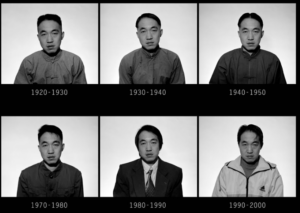 After the Industrial Revolution, it was believed that people were totally capable of changing nature and therefore the world, which led to the weakening of environmental consciousness and negative consequences for humanity. In China today, design is being used to restore the relationship with the natural world. Collaborators from Tsinghua University, Tongji University College of Design and Innovation, and Shanghai Academy of Fine Arts have approached this concept from three mutually related standpoints. Family is examined by determining what elements most influence the residential spaces we choose today and are creating for the future. Community is addressed by demonstrating how a group of people with a shared vision can imagine, develop, and manage positive social changes by moving beyond consumption to innovation. And nature is explored through a case study of the eco-island Shanghai Chongming, which strikes a careful balance between claiming nature and feeding back into it.
After the Industrial Revolution, it was believed that people were totally capable of changing nature and therefore the world, which led to the weakening of environmental consciousness and negative consequences for humanity. In China today, design is being used to restore the relationship with the natural world. Collaborators from Tsinghua University, Tongji University College of Design and Innovation, and Shanghai Academy of Fine Arts have approached this concept from three mutually related standpoints. Family is examined by determining what elements most influence the residential spaces we choose today and are creating for the future. Community is addressed by demonstrating how a group of people with a shared vision can imagine, develop, and manage positive social changes by moving beyond consumption to innovation. And nature is explored through a case study of the eco-island Shanghai Chongming, which strikes a careful balance between claiming nature and feeding back into it.
CUBA
Art and Revolution. The National Art Schools of Havana
COMMISSIONER Norma Rodríguez Derivet – Consejo Nacional Artes Plásticas. CURATOR Jorge Fernández Torres. CO-CURATORS Umberto Zanetti, Christian Zecchin. TEAM Ricardo Porro, Vittorio Garatti, Claudia Scotti Camuzzi, Umberto Zanetti, Christian Zecchin, Andrea Vertua, Michele Paradiso (Università degli Studi di Firenze), Davide Del Curto (Politecnico di Milano), Ana Maria Pedroso Guerrero (Associación Cubeart). FUNDING Rodrigo Rodriquez. SUPPORT Ministerio de Cultura de Cuba, Embajada de Cuba en Roma, Consulado de Cuba en Milán, Consejo Nacional de las Artes Plásticas de Cuba, Instituto Superior de Arte (ISA-ENA), Museo Nacional de Bellas Artes de Cuba, Ambasciata d’Italia a L’Avana, Fondazione Politecnico di Milano.
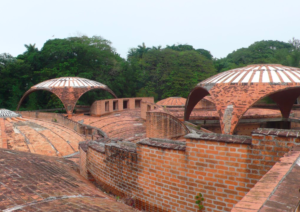 The National Art Schools of Havana were built between 1961 and 1964, one of the most controversial periods of the twentieth century. The Revolution had come to an end, and Fidel Castro and Che Guevara decided to develop a complex of schools devoted to art, music, ballet, modern dance, and drama. The organic architecture was designed in symbiosis with the local vegetation. Here, nature is a source of constant inspiration as well as an integral part of the construction: domes and vaults, light and shade, solids and voids, sounds and silence come together using symbols, metaphors, and allusions. The flexible approach has also enabled the architecture to withstand the tyranny of its tropical environment, which routinely disrupts the physical landscape, forcing continuous adaptations. Despite inevitable deterioration and material difficulties, the schools continue to be a beacon for artistic culture in Cuba and a vibrant place where art is produced and taught using an innovative method based on integration, mutual interaction, and multidirectional influence.
The National Art Schools of Havana were built between 1961 and 1964, one of the most controversial periods of the twentieth century. The Revolution had come to an end, and Fidel Castro and Che Guevara decided to develop a complex of schools devoted to art, music, ballet, modern dance, and drama. The organic architecture was designed in symbiosis with the local vegetation. Here, nature is a source of constant inspiration as well as an integral part of the construction: domes and vaults, light and shade, solids and voids, sounds and silence come together using symbols, metaphors, and allusions. The flexible approach has also enabled the architecture to withstand the tyranny of its tropical environment, which routinely disrupts the physical landscape, forcing continuous adaptations. Despite inevitable deterioration and material difficulties, the schools continue to be a beacon for artistic culture in Cuba and a vibrant place where art is produced and taught using an innovative method based on integration, mutual interaction, and multidirectional influence.
CZECH REPUBLIC
Out of Power Tower and Lithopy
COMMISIONER Helena Koenigsmarková, Director, Museum of Decorative Arts in Prague. CURATOR Iva Knobloch. TEAMS Out of Power Tower: Krištof Kintera with Rastislav Juhás, Josef Fruhauf, Richard Wiesner, Matěj Al Ali, Martina Nosková; Lithopy: Denisa Kera and Petr Šourek (concept and direction), Eva Holá (design), Jan Hrdý (photography), Jaroslav Svítek (installation and 3D print), Denisa Kera and Yair Reshef (blockchain development), Mateusz Kraiński (satellite image processing), with Michal Krásl, Ivan Zelenka, Libor Ščerba, Dan Dittrich, Eva Čechová, Dan Šváb, Barbara Humel, Justin Svoboda, Radim Klásek, Vojtěch Bárta, Roman Trochta, Zdeněk Žatečka, Olga Vincencová, Alice Šourková, Ivana Runštuková, Marie Johnson, Petra Brodská; Štěpán Malovec (graphic design). FUNDING Ministry of Culture of the Czech Republic. support Czech Center, Milan; Gallery Zdeněk Sklenář, Prague.
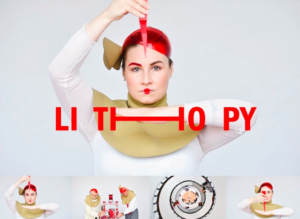 One of the world’s largest lithium reserves was recently discovered at the Czech-German border. Originating with the Big Bang, the element is the most important element for progressive electricity storage. These two projects were developed in response to the ceaseless need for energy and the perils of mineral extraction, scarcity of resources, energy wastage, and the current craze for cryptocurrency. Out of Power Tower is a massive hunk of e-waste: used lithium batteries serve as a metaphorical Tower of Babel, a moral of the Anthropocene. Are we able to stop producing waste and consuming ever more superfluous goods? Are we individually and collectively able, as we face ecological catastrophe, to adopt a modest and frugal lifestyle? Lithopy tells a universal story of power, technology, and ephemeral 4.0 fairy tales in the form of a multiscreen movie backed by blockchain prototypes. Though not yet properly assessed, Czech lithium reserves were quickly turned into a partisan mobilizing tool during the 2017 elections; succumbing to the promise of a lithium paradise for all, the Czech Republic went through a lithium craze without having ever mined a single grain of lithium ore.
One of the world’s largest lithium reserves was recently discovered at the Czech-German border. Originating with the Big Bang, the element is the most important element for progressive electricity storage. These two projects were developed in response to the ceaseless need for energy and the perils of mineral extraction, scarcity of resources, energy wastage, and the current craze for cryptocurrency. Out of Power Tower is a massive hunk of e-waste: used lithium batteries serve as a metaphorical Tower of Babel, a moral of the Anthropocene. Are we able to stop producing waste and consuming ever more superfluous goods? Are we individually and collectively able, as we face ecological catastrophe, to adopt a modest and frugal lifestyle? Lithopy tells a universal story of power, technology, and ephemeral 4.0 fairy tales in the form of a multiscreen movie backed by blockchain prototypes. Though not yet properly assessed, Czech lithium reserves were quickly turned into a partisan mobilizing tool during the 2017 elections; succumbing to the promise of a lithium paradise for all, the Czech Republic went through a lithium craze without having ever mined a single grain of lithium ore.
FINLAND
Everyday Experiments
COMMISSIONER Guy Julier, Aalto University. CURATOR Kaisu Savola, Aalto University. TEAM Nur Horsanali, Saara Kantele, Arja Karhumaa, Ville Kokkonen, Adina Renner, Monica Romagnoli, Tuomas Siitonen, Qin Yang. FUNDING Aalto University and Ministry of Education and Culture, Finland. SUPPORT Ministry for Foreign Affairs of Finland.
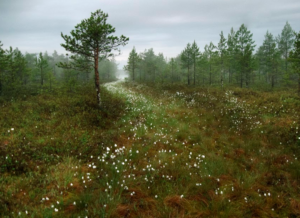 Between 1866 and 1868, a tenth of the Finnish population died from starvation as summer frost destroyed crops. Today, Finland ranks among the richest and happiest countries in the world. Its people have gone from living at the mercy of nature to having a strong command over it. The forest industry provides a major part of the country’s income, while efficient greenhouses produce vegetables in the middle of the winter. Even when the thermometer shows minus-25 degrees Celsius outside, Finns enjoy indoor temperatures warm enough to wear T-shirts. This comfort comes at a cost, however. The Finnish people are known for their close, almost sacred, relationship with nature, but the country’s carbon footprint per capita is among the largest in the world. Bearing in mind this contradiction of caring for nature while acting against it, Everyday Experiments presents twelve projects that address and raise debates around real-life demands, such as the growth of Arctic tourism, the relationships of policy making and civic life, the rights of indigenous communities, and the pursuit of sustainable consumption.
Between 1866 and 1868, a tenth of the Finnish population died from starvation as summer frost destroyed crops. Today, Finland ranks among the richest and happiest countries in the world. Its people have gone from living at the mercy of nature to having a strong command over it. The forest industry provides a major part of the country’s income, while efficient greenhouses produce vegetables in the middle of the winter. Even when the thermometer shows minus-25 degrees Celsius outside, Finns enjoy indoor temperatures warm enough to wear T-shirts. This comfort comes at a cost, however. The Finnish people are known for their close, almost sacred, relationship with nature, but the country’s carbon footprint per capita is among the largest in the world. Bearing in mind this contradiction of caring for nature while acting against it, Everyday Experiments presents twelve projects that address and raise debates around real-life demands, such as the growth of Arctic tourism, the relationships of policy making and civic life, the rights of indigenous communities, and the pursuit of sustainable consumption.
FRANCE
De la pensée au visible. Design as a Large Ring
COMMISSIONER Institut français with the Ministry of Europe and Foreign Affairs and the Ministry of Culture. CURATOR Catherine Geel. SELECTED PROJECTS COMMISSION Sarah Dulac, Clément Gaillard, Elizabeth Hale, Thomas Havet, Tiphaine Kazi-Tani, Anthony Masure, Océane Ragoucy, Lola Carrel (coordination). TEAM Karl Nawrot (graphic design), Sophie Breuil (design); Block Architectes (architecture); Marie Lejault, T&P Work UNit (executive producer); Institut français: Pierre Buhler, Anne Tallineau, Marie-Cécile Burnichon, Vincent Gonzalvez, Mantchini Traoré, Jean-François Guéganno, Hélène Conand, Marie-France Guillin; Institut français Italie: Christian Masset, Christophe Musitelli, Chloé Siganos, Delphine Picart, Pascale Just, Michele Pili. FUNDING AND SUPPORT Ministère de l’Europe des Affaires étrangères: Laurence Auer, Augustin Favereau, Corinne Micaelli, Anne-Sophie Braud; Ministère de la Culture – Direction générale de la création artistique (DGCA): Sylviane Tarsot-Gillery, Béatrice Salmon, Pascal Murgier, Juliette Chevalier, Baptiste Lavenne, Marie-Ange Gonzalez.
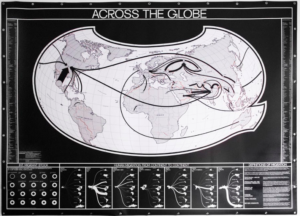 Conceptual and contemplative, the French project asserts the vital role of thinking in design and the importance of the written word as a way of understanding the world. It is built through the mute representation of ideas that either scratch beneath or extend beyond the surface of things, leaving open the question of whether they are there to restore nature or restore our relationship to it. By distance itself from noise, magic bullets, and technical pyrotechnics, it reveals instead another aspect of design, through the dimension of the object it houses: a newly built, virgin surface, devoid of sensational devices, representing the moment at which the design project is born. The large model-surface, surface-landscape, surface-projection is near a bookcase filled with several hundred copies of the same publication. It contains design projects. Readable, these books belong to the surface, they support it. They are the project archive. Here we find many images, texts, diagrams, and sources of inspiration that demonstrably highlight the degraded but vibrant environments in which we live.
Conceptual and contemplative, the French project asserts the vital role of thinking in design and the importance of the written word as a way of understanding the world. It is built through the mute representation of ideas that either scratch beneath or extend beyond the surface of things, leaving open the question of whether they are there to restore nature or restore our relationship to it. By distance itself from noise, magic bullets, and technical pyrotechnics, it reveals instead another aspect of design, through the dimension of the object it houses: a newly built, virgin surface, devoid of sensational devices, representing the moment at which the design project is born. The large model-surface, surface-landscape, surface-projection is near a bookcase filled with several hundred copies of the same publication. It contains design projects. Readable, these books belong to the surface, they support it. They are the project archive. Here we find many images, texts, diagrams, and sources of inspiration that demonstrably highlight the degraded but vibrant environments in which we live.
GERMANY
Carceri d’Invenzione (Imaginary Prisons)
COMMISSIONER Haus der Kulturen der Welt, (HKW) Berlin, a division of Kulturveranstaltungen des Bundes in Berlin GmbH. Bernd Scherer (director), Charlotte Sieben (general manager). Department of Visual Arts and Film: Anselm Franke (head), Agnes Wegner (project management, program coordination), Franziska Janetzky (project coordination), Susanne Förster (project assistant), Amanda Gomez (proofreading). Department of Communications: Daniel Neugebauer, Svetlana Bierl, Kristin Drechsler, Pakorn Duriyaprasit, Tarik Kemper, Karen Khurana, Jan Köhler, Anne Maier, Laura Mühlbauer, Céline Pilch, Josephine Schlegel, Christiane Sonntag, Sabine Westemeier, Sabine Willig. PROJECT Armin Linke in collaboration with Giulia Bruno and Giuseppe Ielasi. CURATOR Anselm Franke. TEAM Rachel O’Reilly, Birgit Schneider, John Palmesino, Etienne Turpin (video lectures). TEAM Armin Linke: Renato Rinaldi (location sound), Kati Simon (project manager), Mevis & Van Deursen (graphic design), Aristide Antonas & Elina Axioti with Martha Schwindling (exhibition architecture), BH audio, San Giuseppe with Giuseppe Ielasi (production, audio and video service), Martina Nadotti (translations). STURDIO Armin Linke: Nicholas Boncardo de Leo, Elena Capra, Laura Fiorio, Ferial Nadja Karrasch, Sarah Poppel, Martina Pozzan, Elisa Scaramuzzino FUNDING The official German contribution is supported by the Federal Foreign Office. HKW is funded by the Federal Government Commissioner for Culture and the Media and by the Federal Foreign Office. Studio Armin Linke has been supported by the project partners Fundació Sorigué (Lleida, Spain), Fondazione Matera-Basilicata 2019 and TBA21–Academy. support Cornell University, ETH Zurich and Singapore-ETH Centre, Norwegian University of Science and Technology, Princeton University, The University of Texas at Austin, Montura Tasci Srl.
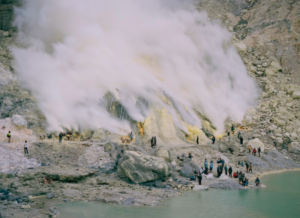 Armin Linke documents the rapid changes occurring at the earth’s surface both photographically and in moving images: places paradigmatic of the fossil-fuel era as well critical sites where changes in the ecosystems of forests, rivers, and oceans have become evident. From vegetable plantations to global centers of climate modeling, from risk managers and re-insurance organizations to carbon dioxide markets and environmental observatories, this snapshot of our present produces a tantalizing image of the interrelations between politics, science, economics, finance, and the logic inherent in technological infrastructures. For this project, Linke and his collaborators have created a theatrical film installation in the central staircase of the Palazzo dell’Arte, a brutalist “archisculpture” designed in the 1960s with two mirrored stairways of raw concrete ascending around a cored-out aperture in an upward spiral recalling a double helix, which enables exploration both temporally and spatially. Like an inhabitable panorama, it invites visitors to experience the relationship between abstract economic and scientific processes and material change, and between laboratories, political institutions, and Earth systems.
Armin Linke documents the rapid changes occurring at the earth’s surface both photographically and in moving images: places paradigmatic of the fossil-fuel era as well critical sites where changes in the ecosystems of forests, rivers, and oceans have become evident. From vegetable plantations to global centers of climate modeling, from risk managers and re-insurance organizations to carbon dioxide markets and environmental observatories, this snapshot of our present produces a tantalizing image of the interrelations between politics, science, economics, finance, and the logic inherent in technological infrastructures. For this project, Linke and his collaborators have created a theatrical film installation in the central staircase of the Palazzo dell’Arte, a brutalist “archisculpture” designed in the 1960s with two mirrored stairways of raw concrete ascending around a cored-out aperture in an upward spiral recalling a double helix, which enables exploration both temporally and spatially. Like an inhabitable panorama, it invites visitors to experience the relationship between abstract economic and scientific processes and material change, and between laboratories, political institutions, and Earth systems.
ITALY
4ELEMENTS/RESPECT
COMMISSIONER Ferruccio Resta, Politecnico di Milano. CURATORS Federico Bucci, Luisa Collina with Marco Bocciolone, Donatella Sciuto and Ico Migliore TEAM Ico Migliore | Migliore+Servetto Architects (art direction), Ilaria Bollati, Laura Daglio, Roberto Dulio, and Laura Galluzzo (editorial team); Ico Migliore e Mara Servetto with Daniela Grimaldi, Daniele Pellizzoni and Giorgia Borroni, Rossella Forioli | Migliore+Servetto Architects (exhibition design); Italo Lupi (book design); Lab Immagine, design department, Politecnico di Milano (photo and movie design), historical research: Historical Archives, Politecnico di Milano; communication and external relations area, Politecnico di Milano; 3M (technical partner), Aldo Colonetti, Paolo Schito (contributors).
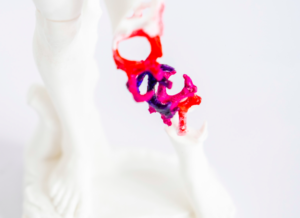 4ELEMENTS/RESPECT is a multidisciplinary archive highlighting “polytechnic” planning—architecture, design, and engineering—in keeping with the four natural elements: a reservoir of passions, attempts, and experiments to heal or repair the dangerous rift between humans and the environment. Water explores energy and water networks, glaciers, hydrogeological risks, chemistry for clean water, waste treatment, electric and wind-powered boats, cultivation systems, and water footprints. Air tells stories of telecommunications, detection, artificial intelligence, big data, secure information circulation, light, innovative services, video games, wind tunnels, wind energy, medical robotics, airplanes, space vehicles, air purity, and pollution control. Fire addresses energy, resistance of materials to high temperatures, heat, fire signs, and seismic risks. Earth is dedicated to bioengineering, nanotechnology, transport networks and their safety, vehicles, care for the built environment, archaeological sites, cultural heritage, natural and agricultural landscapes, and artifacts that accompany our daily lives, whether they are made of recycled, regenerated, or repaired materials, or social and individual behaviors.
4ELEMENTS/RESPECT is a multidisciplinary archive highlighting “polytechnic” planning—architecture, design, and engineering—in keeping with the four natural elements: a reservoir of passions, attempts, and experiments to heal or repair the dangerous rift between humans and the environment. Water explores energy and water networks, glaciers, hydrogeological risks, chemistry for clean water, waste treatment, electric and wind-powered boats, cultivation systems, and water footprints. Air tells stories of telecommunications, detection, artificial intelligence, big data, secure information circulation, light, innovative services, video games, wind tunnels, wind energy, medical robotics, airplanes, space vehicles, air purity, and pollution control. Fire addresses energy, resistance of materials to high temperatures, heat, fire signs, and seismic risks. Earth is dedicated to bioengineering, nanotechnology, transport networks and their safety, vehicles, care for the built environment, archaeological sites, cultural heritage, natural and agricultural landscapes, and artifacts that accompany our daily lives, whether they are made of recycled, regenerated, or repaired materials, or social and individual behaviors.
LEBANON
Tawaf: A Genealogy of a Tree
COMMISSIONER Ministry of Culture, Lebanon. PROJECT Makram el Kadi and Ziad Jamaleddine, L.E.FT Architects. curators Georges Arbid, Shouf Biosphere Reserve, and L.E.FT Architects. team L.E.FT Architects: Rami el Murr, Ibrahim Kombarji; Mayrah Udvardi (research assistant); Shouf reserve: Nizar Hani; Josh Haner / The New York Times (video); Maia Simon (copy editor). funding Italian Embassy in Lebanon. SUPPORT Ministry of Culture, Lebanon; Italian Embassy in Lebanon; MEA.
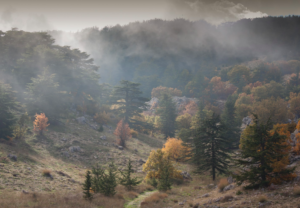 Tawaf, in the Islamic faith, is the devotional act of circling counterclockwise around the Kaaba during the Hajj season. This circular installation of a cross section of a cedar tree unpacks the biblical, literary, popular, and political imaginings of the Lebanese national emblem, exploring geological history, colonialism, and climate change. The most prevalent narrative of the cedar forest’s desertification—that it was historically a lush landscape spoiled and degraded only in recent centuries by local inhabitants—paved the way for the larger imperial project of territorial and economic control disguised as the restoration of the “ancient fertility” of Middle Eastern lands. While previous civilizations did exploit the timber material, the narrow historical view overlooks the longer geologic timeline (stretching back twelve thousand years). Today we know that the genesis of its shrinking ecology can be located to the last ice age. Also eclipsed is the fact that the current global environmental crisis is itself a product of Western industrialization, imported wholesale through the modernization project of the twentieth-century postindependence nation-state.
Tawaf, in the Islamic faith, is the devotional act of circling counterclockwise around the Kaaba during the Hajj season. This circular installation of a cross section of a cedar tree unpacks the biblical, literary, popular, and political imaginings of the Lebanese national emblem, exploring geological history, colonialism, and climate change. The most prevalent narrative of the cedar forest’s desertification—that it was historically a lush landscape spoiled and degraded only in recent centuries by local inhabitants—paved the way for the larger imperial project of territorial and economic control disguised as the restoration of the “ancient fertility” of Middle Eastern lands. While previous civilizations did exploit the timber material, the narrow historical view overlooks the longer geologic timeline (stretching back twelve thousand years). Today we know that the genesis of its shrinking ecology can be located to the last ice age. Also eclipsed is the fact that the current global environmental crisis is itself a product of Western industrialization, imported wholesale through the modernization project of the twentieth-century postindependence nation-state.
LITHUANIA
ARTIST Emilija Škarnulytė. COMMISSIONER Julija Reklaitė. EXHIBITION ARCHITECTURE Linas Lapinskas. ORGANIZER Contemporary Art Centre, Vilnius. TEAM Audrius Antanavičius, Ūla Tornau, Dovilė Grigaliūnaitė, Ilona Virzinkevič, Almantas Lukoševičius. TEXTS Monika Kalinauskaite, Edgaras Gerasimovičiu, Gemma Lloyd. PARTNER Lithuanian Council for Culture.
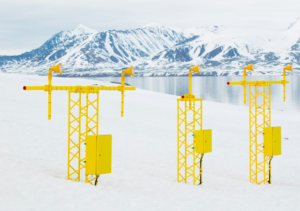 Emilija Škarnulytė’s work provides a philosophical glance at the relationship between human lifespans and longer periods of time. In the current geological period, with everpresent human-caused calamaties such as glacier melt, sea-level rise, and declining wildlife species, we tend to notice less and less. This ultimately affects our view of the world. Škarnulytė explores questions of the beginning of the universe in relation to geological un-grounding processes, invisible structures, geo-traumas, and deep time, as well as how humans and nonhumans become transfigured and woven into the new forms of life—counter-myths for the ideological background of contemporary ecological problems. Manifold is a video installation based on previous works, including a digital rendering of the Super-Kamiokande neutrino observatory in Japan; frames of the Large Hadron Collider at CERN, the largest particle accelerator on the planet; and footage of the artist herself performing as a mermaid-like creature, swimming in ice-cold water of a decommissioned naval base north of the Arctic Circle.
Emilija Škarnulytė’s work provides a philosophical glance at the relationship between human lifespans and longer periods of time. In the current geological period, with everpresent human-caused calamaties such as glacier melt, sea-level rise, and declining wildlife species, we tend to notice less and less. This ultimately affects our view of the world. Škarnulytė explores questions of the beginning of the universe in relation to geological un-grounding processes, invisible structures, geo-traumas, and deep time, as well as how humans and nonhumans become transfigured and woven into the new forms of life—counter-myths for the ideological background of contemporary ecological problems. Manifold is a video installation based on previous works, including a digital rendering of the Super-Kamiokande neutrino observatory in Japan; frames of the Large Hadron Collider at CERN, the largest particle accelerator on the planet; and footage of the artist herself performing as a mermaid-like creature, swimming in ice-cold water of a decommissioned naval base north of the Arctic Circle.
REPUBLIC OF THE UNION OF MYANMAR
Fragments, Elements, and Impermanence of Nature
HIGH PATRONAGE U Myint Naung, Ambassador Extraordinary and Plenipotentiary of the Republic of the Union of Myanmar to Italy. COMMISSIONER Andrea Ganelli, Honorary Consul of Myanmar for North West of Italy and Vice President Chamber of Commerce Italia-Myanmar. PROJECT Aung Myint, Nann Nann, NCS (Nyein Chan Su), Saw Moe Zaw. CURATOR Mauro Salvemini. TEAM Luca Saporiti (deputy commissioner), Antonello Tolve (scientific advisor), Eugenia Battisti (art advisor), Flavio Mastracci (industrial designer), Lorenzo Bar and Stefano Polo (bamboo installation), Gloria Colaianni (graphic designer), Culture2All – Mauro Salvemini ONLUS (general management and supervision). SUPPORT Associazione Italiana Bambù, Floorbamboo/Infloor srl, madeinbamboo.
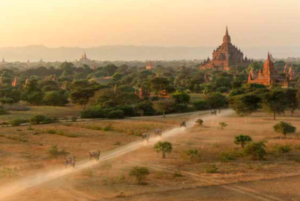 Systems and objects, designed and realized according to the canons of the most contemporary design, mainly satisfy the basic needs that humankind has always had. Yet design nevertheless is often based on ancient, perhaps even innate, rites or rituals. Reparation of nature is necessary following its destruction, however unconsciously, but fear sometimes results in resignation or refusal of awareness. Complexity is such that, contradictorily, simplicity is required to manage it. Nature lacks semantic and physical borders, and aggressive globalization struggles to annihilate it—yet day by day its destructive power increases. Even Myanmar, characterized by wide-open natural spaces, is a country in which significant negative effects on the natural environment occur, as it undergoes an uneasy period of transition. However, local resistance based on considerable natural resources (unfortunately continuously eroded) and on rituals and traditions is still robust—but deeply threatened. In the Myanmar pavilion, natural component is represented by an installation of bamboo as the basis for mindfulness and respect. Nature and traditions. Nature and philosophy. Nature and art.
Systems and objects, designed and realized according to the canons of the most contemporary design, mainly satisfy the basic needs that humankind has always had. Yet design nevertheless is often based on ancient, perhaps even innate, rites or rituals. Reparation of nature is necessary following its destruction, however unconsciously, but fear sometimes results in resignation or refusal of awareness. Complexity is such that, contradictorily, simplicity is required to manage it. Nature lacks semantic and physical borders, and aggressive globalization struggles to annihilate it—yet day by day its destructive power increases. Even Myanmar, characterized by wide-open natural spaces, is a country in which significant negative effects on the natural environment occur, as it undergoes an uneasy period of transition. However, local resistance based on considerable natural resources (unfortunately continuously eroded) and on rituals and traditions is still robust—but deeply threatened. In the Myanmar pavilion, natural component is represented by an installation of bamboo as the basis for mindfulness and respect. Nature and traditions. Nature and philosophy. Nature and art.
THE NETHERLANDS
I See That I See What You Don’t See
CURATORS Angela Rui, design curator, Marina Otero Verzier (director of research at Het Nieuwe Instituut), Francien van Westrenen (head of agency at Het Nieuwe Instituut). PARTICIPANTS Ramon Amaro, Danilo Correale, Design Academy Eindhoven, Het Nieuwe Instituut, departments of Research and Heritage, Academy of Urban Astronauts, Melvin Moti, Oscar Pena, Lucy McRae, Bregtje van der Haak, Richard Vijgen, Leanne Wijnsma. TEAM Mark van der Veen and Ellen Zoete (project managers), Maureen Mooren (art direction), Rudy Guedj (graphic design), Olivier Goethals (spatial design), Eveline Mulckhuyse and Christiane Bosman (communication), Bouwko Landstra and Rob Gijsbers (production).
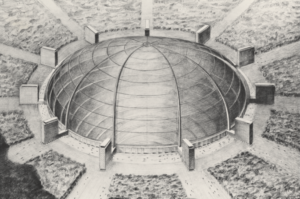 The Netherlands is one of the globe’s most illuminated countries. Its productivity—dependent on data, technology, and energy—supports a twenty-four-hour economy that emphasizes efficiency and growth. At the same time, it reflects a changing relationship with natural rhythms connected to, and affected by, cycles of light and darkness; the traditional dichotomy between day and night no longer seems relevant, and the experience of a clear, starry sky has become a rarity. This hyperconnected and controlled environment is the result of persistent acts of design. The Dutch contribution—research, film, performance, sound, and scent-scapes—speculates on design as both problem and solution, a destructive as well as restorative endeavor. It aims for an understanding of the contrasting effects of light access, deprivation, and overexposure; the influence of radiation on human and nonhuman behaviors; the impact of the maximization of the land by lighting technologies for yearlong crops; the coexistence with the invisible yet pervasive architecture of the digital; the perception of instances of synchronicity with the cosmos; and the role of design in these realms.
The Netherlands is one of the globe’s most illuminated countries. Its productivity—dependent on data, technology, and energy—supports a twenty-four-hour economy that emphasizes efficiency and growth. At the same time, it reflects a changing relationship with natural rhythms connected to, and affected by, cycles of light and darkness; the traditional dichotomy between day and night no longer seems relevant, and the experience of a clear, starry sky has become a rarity. This hyperconnected and controlled environment is the result of persistent acts of design. The Dutch contribution—research, film, performance, sound, and scent-scapes—speculates on design as both problem and solution, a destructive as well as restorative endeavor. It aims for an understanding of the contrasting effects of light access, deprivation, and overexposure; the influence of radiation on human and nonhuman behaviors; the impact of the maximization of the land by lighting technologies for yearlong crops; the coexistence with the invisible yet pervasive architecture of the digital; the perception of instances of synchronicity with the cosmos; and the role of design in these realms.
POLAND
Mycosystem
COMMISSIONER Adam Mickiewicz Institute, Krzysztof Olendzki. project Małgorzata Gurowska. CURATOR Agata Szydłowska TEAM Joanna Halszka-Sokołowska, Mirosława Kopka, Stanisław Łoboziak, Małgorzata Miśkowiec, Maria Ostrowska, Marta Piechocka-Nowakowska, Jan Przedpełski, Emilia Sobczuk. FUNDING Adam Mickiewicz Institute. SUPPORT Consulate General of the Republic of Poland in Milan, Polish Institute in Rome.
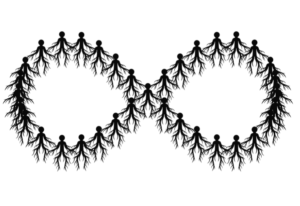 Fungi are everywhere, evoking extreme emotions: mushroom picking is a favorite leisure activity among Poles, yet a fungus in the home is unwelcome and feared. They are a crucial factor in the circulation of matter. Mycorrhiza, a common cooperation between mycelia and plant roots, helps trees grow and, in return, gives the fungi needed carbohydrates. Mushrooms degrade dead organic matter, thereby cleaning our planet and producing fertile soil. And yet mushrooms can also destroy what we produce: they are also responsible for dry rot, which devours timber. For that reason, carpenters use fungicides and treat or cover wood with synthetic substances. As a result, many timber products escape the natural cycle of creation and destruction, cooperation and codependence. How do we return manufacturing back to the cycle of matter circulation? Anthropologist Anna Tsing uses the example of plant and animal relations with fungi to dwell on what she calls collaborative survival. In the Polish pavilion we follow this investigation as well as the role that design can have in restoring broken ties.
Fungi are everywhere, evoking extreme emotions: mushroom picking is a favorite leisure activity among Poles, yet a fungus in the home is unwelcome and feared. They are a crucial factor in the circulation of matter. Mycorrhiza, a common cooperation between mycelia and plant roots, helps trees grow and, in return, gives the fungi needed carbohydrates. Mushrooms degrade dead organic matter, thereby cleaning our planet and producing fertile soil. And yet mushrooms can also destroy what we produce: they are also responsible for dry rot, which devours timber. For that reason, carpenters use fungicides and treat or cover wood with synthetic substances. As a result, many timber products escape the natural cycle of creation and destruction, cooperation and codependence. How do we return manufacturing back to the cycle of matter circulation? Anthropologist Anna Tsing uses the example of plant and animal relations with fungi to dwell on what she calls collaborative survival. In the Polish pavilion we follow this investigation as well as the role that design can have in restoring broken ties.
RUSSIA (Wax Bee)
The Moscow River-Age
COMMISSIONER Dmitry Shvidkovsky. PROJECT Meganom + MARCHI. CURATORS curators Yury Grigoryan, Anna Kamyshan with Bogdan Peric. support Sergey Sitar, Moscow-River Friends.
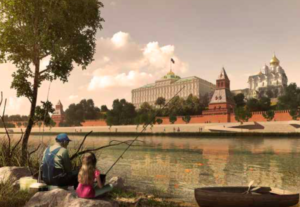 Nature was once considered simply a resource to improve living situations. At the end of the last century, however, natural objects started gaining their own agency and worth, with protections secured for its own benefit. Human-nature relationships have to be mutually beneficial, not exploitative. Yet, this win-win scenario generally remains an ideal rather than reality. In the historical growth of cities, rivers generally lose their force to the demands of development. A flood provokes riverbank reinforcements, channelization, piping, and barrage construction. Shallowing brings construction of ever more dams and other changes in the water system. The Moscow River is no exception—today it is a great example of human and urban domination over nature. And after a hundred years of systematic engineering, it is facing a new wave of exploitation in the form of a massive plan for new public space dependent on riverside development. As an alternative, we offer a reparative design that shows concern for the river itself, a careful and respectful attitude in which friendship and love are central.
Nature was once considered simply a resource to improve living situations. At the end of the last century, however, natural objects started gaining their own agency and worth, with protections secured for its own benefit. Human-nature relationships have to be mutually beneficial, not exploitative. Yet, this win-win scenario generally remains an ideal rather than reality. In the historical growth of cities, rivers generally lose their force to the demands of development. A flood provokes riverbank reinforcements, channelization, piping, and barrage construction. Shallowing brings construction of ever more dams and other changes in the water system. The Moscow River is no exception—today it is a great example of human and urban domination over nature. And after a hundred years of systematic engineering, it is facing a new wave of exploitation in the form of a massive plan for new public space dependent on riverside development. As an alternative, we offer a reparative design that shows concern for the river itself, a careful and respectful attitude in which friendship and love are central.
SLOVENIA
Thinking the Conditions of Our Time
COMMISSIONER Barbara Predan, University of Ljubljana, Academy of Fine Arts and Design. PROJECT Jure Miklavc, Barbara Šušteršič, Silva Vitez, Andrej Šenk, and Jože Carli in collaboration with the team and supporters. CURATORS Tamara Lašič Jurković, Barbara Predan, Valentina Repenšek. TEAM Ajda Bertok, Žiga Hančič, Marko Ježek, Jernej Kapus, Julija Karas, Tamara Lašič Jurković, Ambrož Močnik, Gal Rančigaj, Valentina Repenšek, Mihaela Romanešen, and Hana Železnik (University of Ljubljana, Academy of Fine Arts and Design, Industrial Design and Applied Arts Department). FUNDING Ministry of Economic Development and Technology, University of Ljubljana, Academy of Fine Arts and Design. SUPPORT Rok Kuhar, Primož Jeza, and Lidija Pritržnik.
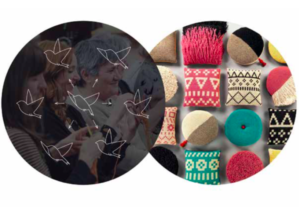 Initially, humans manipulated the environment using strategies that were evolutionarily stable. However, our modes of production since the Enlightenment have involved a negation of our interdependence with the natural world. Instead of harmonizing our practices with the system in its totality, we have been moving toward dominance and destruction. Yet we have the knowledge and ability to give back more than we receive. In order to achieve this, we must change the way we live and operate—our daily routines, our attitude toward the world, our values. Millions of years of evolution have provided nature with fully sustainable, self-sufficient, highly functional systems such as mycorrhiza, pollination, evapotranspiration, and symbiosis. We do not aspire to rote imitation, however. In contrast to the current prevalent approach, wherein technology is elevated above nature, these Slovenian projects utilize natural processes as the basic parameter and foundation for sustainable and social design.
Initially, humans manipulated the environment using strategies that were evolutionarily stable. However, our modes of production since the Enlightenment have involved a negation of our interdependence with the natural world. Instead of harmonizing our practices with the system in its totality, we have been moving toward dominance and destruction. Yet we have the knowledge and ability to give back more than we receive. In order to achieve this, we must change the way we live and operate—our daily routines, our attitude toward the world, our values. Millions of years of evolution have provided nature with fully sustainable, self-sufficient, highly functional systems such as mycorrhiza, pollination, evapotranspiration, and symbiosis. We do not aspire to rote imitation, however. In contrast to the current prevalent approach, wherein technology is elevated above nature, these Slovenian projects utilize natural processes as the basic parameter and foundation for sustainable and social design.
SRI LANKA
A Piece of Sky
COMMISSIONER PromoLanka, Adil Mansoor. PROJECT Peia Associati. CURATOR Anjuli Flamer Caldera SUPPORT Robonica Srl.
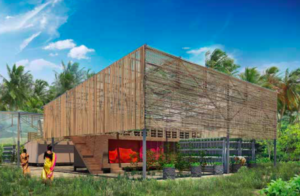 The island nation of Sri Lanka is on the road to recovery, having emerged in 2009 from a three-decade-long civil war that left more than a million people homeless. While the country is experiencing exponential economic and social growth, the government has embarked on a rapid development drive toward establishing basic infrastructure in conflict-affected areas. It has further undertaken the difficult task of attaining national integration and reconciliation among estranged communities, with a housing program targeting internally displaced persons—one that will provide economic livelihood and self-sustenance in addition to basic housing amenities. Given the unique challenges on the ground, program research identifies immediate and reproducible solutions per new strategies aligned with ecological, social, and economic factors. The design centers on providing solutions that can be implemented anywhere through the use of elementary technologies, and provide living space and livelihood together. These devices can be assembled according to available materials and technical skills, even through self-construction on small portions of land saved from climate imbalances. The standard unit provides a self-production of ready-to-consume family goods and living space.
The island nation of Sri Lanka is on the road to recovery, having emerged in 2009 from a three-decade-long civil war that left more than a million people homeless. While the country is experiencing exponential economic and social growth, the government has embarked on a rapid development drive toward establishing basic infrastructure in conflict-affected areas. It has further undertaken the difficult task of attaining national integration and reconciliation among estranged communities, with a housing program targeting internally displaced persons—one that will provide economic livelihood and self-sustenance in addition to basic housing amenities. Given the unique challenges on the ground, program research identifies immediate and reproducible solutions per new strategies aligned with ecological, social, and economic factors. The design centers on providing solutions that can be implemented anywhere through the use of elementary technologies, and provide living space and livelihood together. These devices can be assembled according to available materials and technical skills, even through self-construction on small portions of land saved from climate imbalances. The standard unit provides a self-production of ready-to-consume family goods and living space.
TUNISIA
Genesis and Development of a Natural Culture
COMMISSIONER Prof. Arch. Fakher Kharrat, Headmaster of National School of Architecture and Urbanism of Tunis, in Carthage University. PARTICIPANTS Office Development of Rejim Matoug, Tunisian National Army, Potters of Sejnene, Slaheddine Smaoui, Ridha Rekik, Matali Crasset and Med Nasser. CURATORS Firas Hamdi, Khouloud Lammouchi, Mahdi Ben Tmessek, Aymen Ben Abdallah, Maroua Tarhouni. TEAM Ali Djerbi, Chiraz Saied, Dhaker Akremi, Rabaa Jedidi, Hayfa Ayari, Atef Mazouz, Mahdi Boubaker, Saima Mzoughi, Ahmed Anis Kraem. funding Republic of Tunisia, Ministry of Cultural affairs. SUPPORT Republic of Tunisia, Ministry of Foreign Affairs.
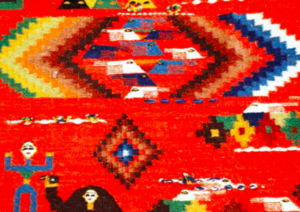 Tunisia is endowed with strong natural, regional, and cultural specificities, and design is the device harnessed to establish living places in the extreme conditions of the desert. In Sejnene, in the far north, the earth is transformed into works of art through the UNESCO-recognized traditions of local potters. In the village of Ken, on the east coast, ancestral craftsmanship practices evoke the Arabic meaning of the word ken, a house with a harmonious and lasting future. In the far west, natural spring water is tapped to create artificial oases in Rejim Maatoug, providing sustainable economic resources for its inhabitants; the traditional brick architecture of Ouled el Hadef in Tozeur is revived in order to safeguard a regional style that reflects the symbiosis between humanity and its environment in the face of ongoing standardization; and architectural traditions are transcended in the contemporary forms at Dar Hi in Nefta, in an effort to restore in an original way the communion between humans and nature.
Tunisia is endowed with strong natural, regional, and cultural specificities, and design is the device harnessed to establish living places in the extreme conditions of the desert. In Sejnene, in the far north, the earth is transformed into works of art through the UNESCO-recognized traditions of local potters. In the village of Ken, on the east coast, ancestral craftsmanship practices evoke the Arabic meaning of the word ken, a house with a harmonious and lasting future. In the far west, natural spring water is tapped to create artificial oases in Rejim Maatoug, providing sustainable economic resources for its inhabitants; the traditional brick architecture of Ouled el Hadef in Tozeur is revived in order to safeguard a regional style that reflects the symbiosis between humanity and its environment in the face of ongoing standardization; and architectural traditions are transcended in the contemporary forms at Dar Hi in Nefta, in an effort to restore in an original way the communion between humans and nature.
UK
Maps of Defiance
COMMISSIONER British Council. PROJECTS Forensic Architecture in collaboration with Yazda. CURATOR Natalie Kane, Victoria & Albert Museum. TEAM Christopher Turner, Victoria & Albert Museum (project director), Paul Bailey (exhibition design), Altofragile (architecture). ADMINISTERING BODIES Victoria & Albert Museum in collaboration with Art Jameel; FUNDING British Council. SUPPORT Arts Council England.
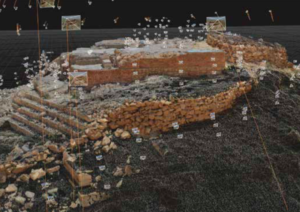 In 2014, the Islamic State (IS) invaded the Sinjar region of northern Iraq, intent on destroying the Yazidi communities that have inhabited the area since the twelfth century. Their campaign of violence against the ethnic and religious minority included the systematic killing, torture, and sexual enslavement of Yazidi people, and the widespread destruction of their homes, agriculture, shrines, and mausoleums. In 2018, Forensic Architecture—an interdisciplinary team of investigators, artists, architects, archaeologists, filmmakers, software developers, lawyers, and journalists—in collaboration with the NGO Yazda, set out to document crimes committed by IS, and to train a ground team to collect evidence to support legal cases against IS members. Local investigators were equipped with a tool kit of advanced digital techniques and accessible DIY methods, such as rigs made from kites, plastic bottles, and helium balloons to be used for aerial photography in dangerous locations. The installation demonstrates the importance of acknowledging the destruction of cultural heritage as a part of genocide itself.
In 2014, the Islamic State (IS) invaded the Sinjar region of northern Iraq, intent on destroying the Yazidi communities that have inhabited the area since the twelfth century. Their campaign of violence against the ethnic and religious minority included the systematic killing, torture, and sexual enslavement of Yazidi people, and the widespread destruction of their homes, agriculture, shrines, and mausoleums. In 2018, Forensic Architecture—an interdisciplinary team of investigators, artists, architects, archaeologists, filmmakers, software developers, lawyers, and journalists—in collaboration with the NGO Yazda, set out to document crimes committed by IS, and to train a ground team to collect evidence to support legal cases against IS members. Local investigators were equipped with a tool kit of advanced digital techniques and accessible DIY methods, such as rigs made from kites, plastic bottles, and helium balloons to be used for aerial photography in dangerous locations. The installation demonstrates the importance of acknowledging the destruction of cultural heritage as a part of genocide itself.
USA
RECKONstruct
COMMISSIONER Gregory Norris, SHINE@ MIT. CHIEF CURATOR Russell Fortmeyer, Arup. CURATORS Jane Abernethy and Mesve Vardar, Humanscale; Frances Yang, Arup. TEAM Arup: Paul Chavez, Matthew Wilkinson, Ashley Hastings (exhibition design); Novità: Chris Abbate, Danielle McWilliams, Barbara Musso; Humanscale: Tina Brennan (project coordination).
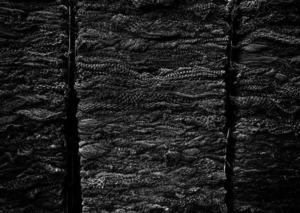 Sustainability is the ultimate design problem. In our current state of broken nature, we see the ocean filling with plastic, accelerated climate change beyond our expectations, and toxins everywhere, including inside our bodies. Incremental change cannot address the magnitude and urgency of our environmental challenges.RECKONstruct demonstrates how design can respond to this crisis, documenting the collaborative process a group of US designers developed in 2018 to reimagine a simple product through three different approaches to sustainability. If design begins with asking questions, sustainable design demands we frame those questions differently. What does a product look like when made entirely from waste? How is it different when the tenets of biomimicry are followed? Is it possible to use grown materials? Most importantly, are the design solutions better? In which ways, how much, and for whom? The Massachusetts Institute of Technology’s SHINE program—Sustainability and Health Initiative for NetPositive Enterprise—evaluated each design concept using a regenerative life cycle assessment (LCA) process to confirm and quantify the impacts.
Sustainability is the ultimate design problem. In our current state of broken nature, we see the ocean filling with plastic, accelerated climate change beyond our expectations, and toxins everywhere, including inside our bodies. Incremental change cannot address the magnitude and urgency of our environmental challenges.RECKONstruct demonstrates how design can respond to this crisis, documenting the collaborative process a group of US designers developed in 2018 to reimagine a simple product through three different approaches to sustainability. If design begins with asking questions, sustainable design demands we frame those questions differently. What does a product look like when made entirely from waste? How is it different when the tenets of biomimicry are followed? Is it possible to use grown materials? Most importantly, are the design solutions better? In which ways, how much, and for whom? The Massachusetts Institute of Technology’s SHINE program—Sustainability and Health Initiative for NetPositive Enterprise—evaluated each design concept using a regenerative life cycle assessment (LCA) process to confirm and quantify the impacts.


 Algeria’s potential can be capitalized on by mobilizing local know-how, based on local and regional history, which has a strong identity and is promoted by quality processes. These processes should become the focus of new socioeconomic sectors aimed at strengthening “heritagization.” The public—the main actor—can become more involved in the appropriation of these resources by mobilizing their capacities, reverting to past techniques of territorial marketing, and promoting community practices, such as the use of the fougara plantation irrigation system in the southern city of Ghardaïa, and earthen architecture, evidence of several civilizations, scattered across the country. By reducing the opposition between modernity and tradition, tourism will be encouraged and therefore the mobilization necessary for sustainability can be achieved. The value system behind heritagization processes in this new vision of territorial development attempts to reduce the opposition between modernity and tradition.
Algeria’s potential can be capitalized on by mobilizing local know-how, based on local and regional history, which has a strong identity and is promoted by quality processes. These processes should become the focus of new socioeconomic sectors aimed at strengthening “heritagization.” The public—the main actor—can become more involved in the appropriation of these resources by mobilizing their capacities, reverting to past techniques of territorial marketing, and promoting community practices, such as the use of the fougara plantation irrigation system in the southern city of Ghardaïa, and earthen architecture, evidence of several civilizations, scattered across the country. By reducing the opposition between modernity and tradition, tourism will be encouraged and therefore the mobilization necessary for sustainability can be achieved. The value system behind heritagization processes in this new vision of territorial development attempts to reduce the opposition between modernity and tradition. Recent massive coral bleaching events rendered visible the plausible death of the Great Barrier Reef. In response, the Australian government partially outsourced the preservation of the earth’s largest living structure to a nonprofit supported by major minings, banking, insurance, airline, and fossil-fuel corporations. To address the impact of such a hegemonic economic system of oversight, the United Nations Intergovernmental Panel on Climate Change took control of the land-water enclave and the algorithmic technologies previously deployed on site. Teatro della Terra Alienata stages a fictional scenario of territorial secession, proposing a reappropriation, expansion, and concatenation of existing technologies of surveillance and ecological management embedded in the life cycles of the reef. Inspired by Laboria Cuboniks’s Xenofeminist manifesto, these technologies become the poetic arsenal for a rational, universalist project of emancipation. The pavilion consolidates two years of research and pedagogical projects that engage with the crisis of the political imagination as a form of institutional critique.
Recent massive coral bleaching events rendered visible the plausible death of the Great Barrier Reef. In response, the Australian government partially outsourced the preservation of the earth’s largest living structure to a nonprofit supported by major minings, banking, insurance, airline, and fossil-fuel corporations. To address the impact of such a hegemonic economic system of oversight, the United Nations Intergovernmental Panel on Climate Change took control of the land-water enclave and the algorithmic technologies previously deployed on site. Teatro della Terra Alienata stages a fictional scenario of territorial secession, proposing a reappropriation, expansion, and concatenation of existing technologies of surveillance and ecological management embedded in the life cycles of the reef. Inspired by Laboria Cuboniks’s Xenofeminist manifesto, these technologies become the poetic arsenal for a rational, universalist project of emancipation. The pavilion consolidates two years of research and pedagogical projects that engage with the crisis of the political imagination as a form of institutional critique. Circular Flows is a collaboration with Swiss water research institute Eawag, a pioneer in the field of urine separation. Acceptance of toilet systems based on separation of waste materials has to date been hampered not by technological factors, but by negative user experience through inadequate design. After years of joint research, EOOS has developed a new technology for simply separating urine in a flush toilet without the user’s ever noticing. Urine Trap allows significant amounts of nitrogen and phosphorus excreted in human urine to be removed from wastewater, collected locally in tanks, and then processed to be used as fertilizer. In urban catchment areas, too much nitrogen leads to increased algae growth in river estuaries; when the algae die off, water in the coastal regions is deprived of oxygen, resulting in dead zones where no life can exist. The public remains largely ignorant of the dangers of nitrogen in wastewater and agrarian fertilizers.
Circular Flows is a collaboration with Swiss water research institute Eawag, a pioneer in the field of urine separation. Acceptance of toilet systems based on separation of waste materials has to date been hampered not by technological factors, but by negative user experience through inadequate design. After years of joint research, EOOS has developed a new technology for simply separating urine in a flush toilet without the user’s ever noticing. Urine Trap allows significant amounts of nitrogen and phosphorus excreted in human urine to be removed from wastewater, collected locally in tanks, and then processed to be used as fertilizer. In urban catchment areas, too much nitrogen leads to increased algae growth in river estuaries; when the algae die off, water in the coastal regions is deprived of oxygen, resulting in dead zones where no life can exist. The public remains largely ignorant of the dangers of nitrogen in wastewater and agrarian fertilizers. After the Industrial Revolution, it was believed that people were totally capable of changing nature and therefore the world, which led to the weakening of environmental consciousness and negative consequences for humanity. In China today, design is being used to restore the relationship with the natural world. Collaborators from Tsinghua University, Tongji University College of Design and Innovation, and Shanghai Academy of Fine Arts have approached this concept from three mutually related standpoints. Family is examined by determining what elements most influence the residential spaces we choose today and are creating for the future. Community is addressed by demonstrating how a group of people with a shared vision can imagine, develop, and manage positive social changes by moving beyond consumption to innovation. And nature is explored through a case study of the eco-island Shanghai Chongming, which strikes a careful balance between claiming nature and feeding back into it.
After the Industrial Revolution, it was believed that people were totally capable of changing nature and therefore the world, which led to the weakening of environmental consciousness and negative consequences for humanity. In China today, design is being used to restore the relationship with the natural world. Collaborators from Tsinghua University, Tongji University College of Design and Innovation, and Shanghai Academy of Fine Arts have approached this concept from three mutually related standpoints. Family is examined by determining what elements most influence the residential spaces we choose today and are creating for the future. Community is addressed by demonstrating how a group of people with a shared vision can imagine, develop, and manage positive social changes by moving beyond consumption to innovation. And nature is explored through a case study of the eco-island Shanghai Chongming, which strikes a careful balance between claiming nature and feeding back into it. The National Art Schools of Havana were built between 1961 and 1964, one of the most controversial periods of the twentieth century. The Revolution had come to an end, and Fidel Castro and Che Guevara decided to develop a complex of schools devoted to art, music, ballet, modern dance, and drama. The organic architecture was designed in symbiosis with the local vegetation. Here, nature is a source of constant inspiration as well as an integral part of the construction: domes and vaults, light and shade, solids and voids, sounds and silence come together using symbols, metaphors, and allusions. The flexible approach has also enabled the architecture to withstand the tyranny of its tropical environment, which routinely disrupts the physical landscape, forcing continuous adaptations. Despite inevitable deterioration and material difficulties, the schools continue to be a beacon for artistic culture in Cuba and a vibrant place where art is produced and taught using an innovative method based on integration, mutual interaction, and multidirectional influence.
The National Art Schools of Havana were built between 1961 and 1964, one of the most controversial periods of the twentieth century. The Revolution had come to an end, and Fidel Castro and Che Guevara decided to develop a complex of schools devoted to art, music, ballet, modern dance, and drama. The organic architecture was designed in symbiosis with the local vegetation. Here, nature is a source of constant inspiration as well as an integral part of the construction: domes and vaults, light and shade, solids and voids, sounds and silence come together using symbols, metaphors, and allusions. The flexible approach has also enabled the architecture to withstand the tyranny of its tropical environment, which routinely disrupts the physical landscape, forcing continuous adaptations. Despite inevitable deterioration and material difficulties, the schools continue to be a beacon for artistic culture in Cuba and a vibrant place where art is produced and taught using an innovative method based on integration, mutual interaction, and multidirectional influence. One of the world’s largest lithium reserves was recently discovered at the Czech-German border. Originating with the Big Bang, the element is the most important element for progressive electricity storage. These two projects were developed in response to the ceaseless need for energy and the perils of mineral extraction, scarcity of resources, energy wastage, and the current craze for cryptocurrency. Out of Power Tower is a massive hunk of e-waste: used lithium batteries serve as a metaphorical Tower of Babel, a moral of the Anthropocene. Are we able to stop producing waste and consuming ever more superfluous goods? Are we individually and collectively able, as we face ecological catastrophe, to adopt a modest and frugal lifestyle? Lithopy tells a universal story of power, technology, and ephemeral 4.0 fairy tales in the form of a multiscreen movie backed by blockchain prototypes. Though not yet properly assessed, Czech lithium reserves were quickly turned into a partisan mobilizing tool during the 2017 elections; succumbing to the promise of a lithium paradise for all, the Czech Republic went through a lithium craze without having ever mined a single grain of lithium ore.
One of the world’s largest lithium reserves was recently discovered at the Czech-German border. Originating with the Big Bang, the element is the most important element for progressive electricity storage. These two projects were developed in response to the ceaseless need for energy and the perils of mineral extraction, scarcity of resources, energy wastage, and the current craze for cryptocurrency. Out of Power Tower is a massive hunk of e-waste: used lithium batteries serve as a metaphorical Tower of Babel, a moral of the Anthropocene. Are we able to stop producing waste and consuming ever more superfluous goods? Are we individually and collectively able, as we face ecological catastrophe, to adopt a modest and frugal lifestyle? Lithopy tells a universal story of power, technology, and ephemeral 4.0 fairy tales in the form of a multiscreen movie backed by blockchain prototypes. Though not yet properly assessed, Czech lithium reserves were quickly turned into a partisan mobilizing tool during the 2017 elections; succumbing to the promise of a lithium paradise for all, the Czech Republic went through a lithium craze without having ever mined a single grain of lithium ore. Between 1866 and 1868, a tenth of the Finnish population died from starvation as summer frost destroyed crops. Today, Finland ranks among the richest and happiest countries in the world. Its people have gone from living at the mercy of nature to having a strong command over it. The forest industry provides a major part of the country’s income, while efficient greenhouses produce vegetables in the middle of the winter. Even when the thermometer shows minus-25 degrees Celsius outside, Finns enjoy indoor temperatures warm enough to wear T-shirts. This comfort comes at a cost, however. The Finnish people are known for their close, almost sacred, relationship with nature, but the country’s carbon footprint per capita is among the largest in the world. Bearing in mind this contradiction of caring for nature while acting against it, Everyday Experiments presents twelve projects that address and raise debates around real-life demands, such as the growth of Arctic tourism, the relationships of policy making and civic life, the rights of indigenous communities, and the pursuit of sustainable consumption.
Between 1866 and 1868, a tenth of the Finnish population died from starvation as summer frost destroyed crops. Today, Finland ranks among the richest and happiest countries in the world. Its people have gone from living at the mercy of nature to having a strong command over it. The forest industry provides a major part of the country’s income, while efficient greenhouses produce vegetables in the middle of the winter. Even when the thermometer shows minus-25 degrees Celsius outside, Finns enjoy indoor temperatures warm enough to wear T-shirts. This comfort comes at a cost, however. The Finnish people are known for their close, almost sacred, relationship with nature, but the country’s carbon footprint per capita is among the largest in the world. Bearing in mind this contradiction of caring for nature while acting against it, Everyday Experiments presents twelve projects that address and raise debates around real-life demands, such as the growth of Arctic tourism, the relationships of policy making and civic life, the rights of indigenous communities, and the pursuit of sustainable consumption. Conceptual and contemplative, the French project asserts the vital role of thinking in design and the importance of the written word as a way of understanding the world. It is built through the mute representation of ideas that either scratch beneath or extend beyond the surface of things, leaving open the question of whether they are there to restore nature or restore our relationship to it. By distance itself from noise, magic bullets, and technical pyrotechnics, it reveals instead another aspect of design, through the dimension of the object it houses: a newly built, virgin surface, devoid of sensational devices, representing the moment at which the design project is born. The large model-surface, surface-landscape, surface-projection is near a bookcase filled with several hundred copies of the same publication. It contains design projects. Readable, these books belong to the surface, they support it. They are the project archive. Here we find many images, texts, diagrams, and sources of inspiration that demonstrably highlight the degraded but vibrant environments in which we live.
Conceptual and contemplative, the French project asserts the vital role of thinking in design and the importance of the written word as a way of understanding the world. It is built through the mute representation of ideas that either scratch beneath or extend beyond the surface of things, leaving open the question of whether they are there to restore nature or restore our relationship to it. By distance itself from noise, magic bullets, and technical pyrotechnics, it reveals instead another aspect of design, through the dimension of the object it houses: a newly built, virgin surface, devoid of sensational devices, representing the moment at which the design project is born. The large model-surface, surface-landscape, surface-projection is near a bookcase filled with several hundred copies of the same publication. It contains design projects. Readable, these books belong to the surface, they support it. They are the project archive. Here we find many images, texts, diagrams, and sources of inspiration that demonstrably highlight the degraded but vibrant environments in which we live. Armin Linke documents the rapid changes occurring at the earth’s surface both photographically and in moving images: places paradigmatic of the fossil-fuel era as well critical sites where changes in the ecosystems of forests, rivers, and oceans have become evident. From vegetable plantations to global centers of climate modeling, from risk managers and re-insurance organizations to carbon dioxide markets and environmental observatories, this snapshot of our present produces a tantalizing image of the interrelations between politics, science, economics, finance, and the logic inherent in technological infrastructures. For this project, Linke and his collaborators have created a theatrical film installation in the central staircase of the Palazzo dell’Arte, a brutalist “archisculpture” designed in the 1960s with two mirrored stairways of raw concrete ascending around a cored-out aperture in an upward spiral recalling a double helix, which enables exploration both temporally and spatially. Like an inhabitable panorama, it invites visitors to experience the relationship between abstract economic and scientific processes and material change, and between laboratories, political institutions, and Earth systems.
Armin Linke documents the rapid changes occurring at the earth’s surface both photographically and in moving images: places paradigmatic of the fossil-fuel era as well critical sites where changes in the ecosystems of forests, rivers, and oceans have become evident. From vegetable plantations to global centers of climate modeling, from risk managers and re-insurance organizations to carbon dioxide markets and environmental observatories, this snapshot of our present produces a tantalizing image of the interrelations between politics, science, economics, finance, and the logic inherent in technological infrastructures. For this project, Linke and his collaborators have created a theatrical film installation in the central staircase of the Palazzo dell’Arte, a brutalist “archisculpture” designed in the 1960s with two mirrored stairways of raw concrete ascending around a cored-out aperture in an upward spiral recalling a double helix, which enables exploration both temporally and spatially. Like an inhabitable panorama, it invites visitors to experience the relationship between abstract economic and scientific processes and material change, and between laboratories, political institutions, and Earth systems. 4ELEMENTS/RESPECT is a multidisciplinary archive highlighting “polytechnic” planning—architecture, design, and engineering—in keeping with the four natural elements: a reservoir of passions, attempts, and experiments to heal or repair the dangerous rift between humans and the environment. Water explores energy and water networks, glaciers, hydrogeological risks, chemistry for clean water, waste treatment, electric and wind-powered boats, cultivation systems, and water footprints. Air tells stories of telecommunications, detection, artificial intelligence, big data, secure information circulation, light, innovative services, video games, wind tunnels, wind energy, medical robotics, airplanes, space vehicles, air purity, and pollution control. Fire addresses energy, resistance of materials to high temperatures, heat, fire signs, and seismic risks. Earth is dedicated to bioengineering, nanotechnology, transport networks and their safety, vehicles, care for the built environment, archaeological sites, cultural heritage, natural and agricultural landscapes, and artifacts that accompany our daily lives, whether they are made of recycled, regenerated, or repaired materials, or social and individual behaviors.
4ELEMENTS/RESPECT is a multidisciplinary archive highlighting “polytechnic” planning—architecture, design, and engineering—in keeping with the four natural elements: a reservoir of passions, attempts, and experiments to heal or repair the dangerous rift between humans and the environment. Water explores energy and water networks, glaciers, hydrogeological risks, chemistry for clean water, waste treatment, electric and wind-powered boats, cultivation systems, and water footprints. Air tells stories of telecommunications, detection, artificial intelligence, big data, secure information circulation, light, innovative services, video games, wind tunnels, wind energy, medical robotics, airplanes, space vehicles, air purity, and pollution control. Fire addresses energy, resistance of materials to high temperatures, heat, fire signs, and seismic risks. Earth is dedicated to bioengineering, nanotechnology, transport networks and their safety, vehicles, care for the built environment, archaeological sites, cultural heritage, natural and agricultural landscapes, and artifacts that accompany our daily lives, whether they are made of recycled, regenerated, or repaired materials, or social and individual behaviors. Tawaf, in the Islamic faith, is the devotional act of circling counterclockwise around the Kaaba during the Hajj season. This circular installation of a cross section of a cedar tree unpacks the biblical, literary, popular, and political imaginings of the Lebanese national emblem, exploring geological history, colonialism, and climate change. The most prevalent narrative of the cedar forest’s desertification—that it was historically a lush landscape spoiled and degraded only in recent centuries by local inhabitants—paved the way for the larger imperial project of territorial and economic control disguised as the restoration of the “ancient fertility” of Middle Eastern lands. While previous civilizations did exploit the timber material, the narrow historical view overlooks the longer geologic timeline (stretching back twelve thousand years). Today we know that the genesis of its shrinking ecology can be located to the last ice age. Also eclipsed is the fact that the current global environmental crisis is itself a product of Western industrialization, imported wholesale through the modernization project of the twentieth-century postindependence nation-state.
Tawaf, in the Islamic faith, is the devotional act of circling counterclockwise around the Kaaba during the Hajj season. This circular installation of a cross section of a cedar tree unpacks the biblical, literary, popular, and political imaginings of the Lebanese national emblem, exploring geological history, colonialism, and climate change. The most prevalent narrative of the cedar forest’s desertification—that it was historically a lush landscape spoiled and degraded only in recent centuries by local inhabitants—paved the way for the larger imperial project of territorial and economic control disguised as the restoration of the “ancient fertility” of Middle Eastern lands. While previous civilizations did exploit the timber material, the narrow historical view overlooks the longer geologic timeline (stretching back twelve thousand years). Today we know that the genesis of its shrinking ecology can be located to the last ice age. Also eclipsed is the fact that the current global environmental crisis is itself a product of Western industrialization, imported wholesale through the modernization project of the twentieth-century postindependence nation-state. Emilija Škarnulytė’s work provides a philosophical glance at the relationship between human lifespans and longer periods of time. In the current geological period, with everpresent human-caused calamaties such as glacier melt, sea-level rise, and declining wildlife species, we tend to notice less and less. This ultimately affects our view of the world. Škarnulytė explores questions of the beginning of the universe in relation to geological un-grounding processes, invisible structures, geo-traumas, and deep time, as well as how humans and nonhumans become transfigured and woven into the new forms of life—counter-myths for the ideological background of contemporary ecological problems. Manifold is a video installation based on previous works, including a digital rendering of the Super-Kamiokande neutrino observatory in Japan; frames of the Large Hadron Collider at CERN, the largest particle accelerator on the planet; and footage of the artist herself performing as a mermaid-like creature, swimming in ice-cold water of a decommissioned naval base north of the Arctic Circle.
Emilija Škarnulytė’s work provides a philosophical glance at the relationship between human lifespans and longer periods of time. In the current geological period, with everpresent human-caused calamaties such as glacier melt, sea-level rise, and declining wildlife species, we tend to notice less and less. This ultimately affects our view of the world. Škarnulytė explores questions of the beginning of the universe in relation to geological un-grounding processes, invisible structures, geo-traumas, and deep time, as well as how humans and nonhumans become transfigured and woven into the new forms of life—counter-myths for the ideological background of contemporary ecological problems. Manifold is a video installation based on previous works, including a digital rendering of the Super-Kamiokande neutrino observatory in Japan; frames of the Large Hadron Collider at CERN, the largest particle accelerator on the planet; and footage of the artist herself performing as a mermaid-like creature, swimming in ice-cold water of a decommissioned naval base north of the Arctic Circle. Systems and objects, designed and realized according to the canons of the most contemporary design, mainly satisfy the basic needs that humankind has always had. Yet design nevertheless is often based on ancient, perhaps even innate, rites or rituals. Reparation of nature is necessary following its destruction, however unconsciously, but fear sometimes results in resignation or refusal of awareness. Complexity is such that, contradictorily, simplicity is required to manage it. Nature lacks semantic and physical borders, and aggressive globalization struggles to annihilate it—yet day by day its destructive power increases. Even Myanmar, characterized by wide-open natural spaces, is a country in which significant negative effects on the natural environment occur, as it undergoes an uneasy period of transition. However, local resistance based on considerable natural resources (unfortunately continuously eroded) and on rituals and traditions is still robust—but deeply threatened. In the Myanmar pavilion, natural component is represented by an installation of bamboo as the basis for mindfulness and respect. Nature and traditions. Nature and philosophy. Nature and art.
Systems and objects, designed and realized according to the canons of the most contemporary design, mainly satisfy the basic needs that humankind has always had. Yet design nevertheless is often based on ancient, perhaps even innate, rites or rituals. Reparation of nature is necessary following its destruction, however unconsciously, but fear sometimes results in resignation or refusal of awareness. Complexity is such that, contradictorily, simplicity is required to manage it. Nature lacks semantic and physical borders, and aggressive globalization struggles to annihilate it—yet day by day its destructive power increases. Even Myanmar, characterized by wide-open natural spaces, is a country in which significant negative effects on the natural environment occur, as it undergoes an uneasy period of transition. However, local resistance based on considerable natural resources (unfortunately continuously eroded) and on rituals and traditions is still robust—but deeply threatened. In the Myanmar pavilion, natural component is represented by an installation of bamboo as the basis for mindfulness and respect. Nature and traditions. Nature and philosophy. Nature and art. The Netherlands is one of the globe’s most illuminated countries. Its productivity—dependent on data, technology, and energy—supports a twenty-four-hour economy that emphasizes efficiency and growth. At the same time, it reflects a changing relationship with natural rhythms connected to, and affected by, cycles of light and darkness; the traditional dichotomy between day and night no longer seems relevant, and the experience of a clear, starry sky has become a rarity. This hyperconnected and controlled environment is the result of persistent acts of design. The Dutch contribution—research, film, performance, sound, and scent-scapes—speculates on design as both problem and solution, a destructive as well as restorative endeavor. It aims for an understanding of the contrasting effects of light access, deprivation, and overexposure; the influence of radiation on human and nonhuman behaviors; the impact of the maximization of the land by lighting technologies for yearlong crops; the coexistence with the invisible yet pervasive architecture of the digital; the perception of instances of synchronicity with the cosmos; and the role of design in these realms.
The Netherlands is one of the globe’s most illuminated countries. Its productivity—dependent on data, technology, and energy—supports a twenty-four-hour economy that emphasizes efficiency and growth. At the same time, it reflects a changing relationship with natural rhythms connected to, and affected by, cycles of light and darkness; the traditional dichotomy between day and night no longer seems relevant, and the experience of a clear, starry sky has become a rarity. This hyperconnected and controlled environment is the result of persistent acts of design. The Dutch contribution—research, film, performance, sound, and scent-scapes—speculates on design as both problem and solution, a destructive as well as restorative endeavor. It aims for an understanding of the contrasting effects of light access, deprivation, and overexposure; the influence of radiation on human and nonhuman behaviors; the impact of the maximization of the land by lighting technologies for yearlong crops; the coexistence with the invisible yet pervasive architecture of the digital; the perception of instances of synchronicity with the cosmos; and the role of design in these realms. Fungi are everywhere, evoking extreme emotions: mushroom picking is a favorite leisure activity among Poles, yet a fungus in the home is unwelcome and feared. They are a crucial factor in the circulation of matter. Mycorrhiza, a common cooperation between mycelia and plant roots, helps trees grow and, in return, gives the fungi needed carbohydrates. Mushrooms degrade dead organic matter, thereby cleaning our planet and producing fertile soil. And yet mushrooms can also destroy what we produce: they are also responsible for dry rot, which devours timber. For that reason, carpenters use fungicides and treat or cover wood with synthetic substances. As a result, many timber products escape the natural cycle of creation and destruction, cooperation and codependence. How do we return manufacturing back to the cycle of matter circulation? Anthropologist Anna Tsing uses the example of plant and animal relations with fungi to dwell on what she calls collaborative survival. In the Polish pavilion we follow this investigation as well as the role that design can have in restoring broken ties.
Fungi are everywhere, evoking extreme emotions: mushroom picking is a favorite leisure activity among Poles, yet a fungus in the home is unwelcome and feared. They are a crucial factor in the circulation of matter. Mycorrhiza, a common cooperation between mycelia and plant roots, helps trees grow and, in return, gives the fungi needed carbohydrates. Mushrooms degrade dead organic matter, thereby cleaning our planet and producing fertile soil. And yet mushrooms can also destroy what we produce: they are also responsible for dry rot, which devours timber. For that reason, carpenters use fungicides and treat or cover wood with synthetic substances. As a result, many timber products escape the natural cycle of creation and destruction, cooperation and codependence. How do we return manufacturing back to the cycle of matter circulation? Anthropologist Anna Tsing uses the example of plant and animal relations with fungi to dwell on what she calls collaborative survival. In the Polish pavilion we follow this investigation as well as the role that design can have in restoring broken ties. Nature was once considered simply a resource to improve living situations. At the end of the last century, however, natural objects started gaining their own agency and worth, with protections secured for its own benefit. Human-nature relationships have to be mutually beneficial, not exploitative. Yet, this win-win scenario generally remains an ideal rather than reality. In the historical growth of cities, rivers generally lose their force to the demands of development. A flood provokes riverbank reinforcements, channelization, piping, and barrage construction. Shallowing brings construction of ever more dams and other changes in the water system. The Moscow River is no exception—today it is a great example of human and urban domination over nature. And after a hundred years of systematic engineering, it is facing a new wave of exploitation in the form of a massive plan for new public space dependent on riverside development. As an alternative, we offer a reparative design that shows concern for the river itself, a careful and respectful attitude in which friendship and love are central.
Nature was once considered simply a resource to improve living situations. At the end of the last century, however, natural objects started gaining their own agency and worth, with protections secured for its own benefit. Human-nature relationships have to be mutually beneficial, not exploitative. Yet, this win-win scenario generally remains an ideal rather than reality. In the historical growth of cities, rivers generally lose their force to the demands of development. A flood provokes riverbank reinforcements, channelization, piping, and barrage construction. Shallowing brings construction of ever more dams and other changes in the water system. The Moscow River is no exception—today it is a great example of human and urban domination over nature. And after a hundred years of systematic engineering, it is facing a new wave of exploitation in the form of a massive plan for new public space dependent on riverside development. As an alternative, we offer a reparative design that shows concern for the river itself, a careful and respectful attitude in which friendship and love are central. Initially, humans manipulated the environment using strategies that were evolutionarily stable. However, our modes of production since the Enlightenment have involved a negation of our interdependence with the natural world. Instead of harmonizing our practices with the system in its totality, we have been moving toward dominance and destruction. Yet we have the knowledge and ability to give back more than we receive. In order to achieve this, we must change the way we live and operate—our daily routines, our attitude toward the world, our values. Millions of years of evolution have provided nature with fully sustainable, self-sufficient, highly functional systems such as mycorrhiza, pollination, evapotranspiration, and symbiosis. We do not aspire to rote imitation, however. In contrast to the current prevalent approach, wherein technology is elevated above nature, these Slovenian projects utilize natural processes as the basic parameter and foundation for sustainable and social design.
Initially, humans manipulated the environment using strategies that were evolutionarily stable. However, our modes of production since the Enlightenment have involved a negation of our interdependence with the natural world. Instead of harmonizing our practices with the system in its totality, we have been moving toward dominance and destruction. Yet we have the knowledge and ability to give back more than we receive. In order to achieve this, we must change the way we live and operate—our daily routines, our attitude toward the world, our values. Millions of years of evolution have provided nature with fully sustainable, self-sufficient, highly functional systems such as mycorrhiza, pollination, evapotranspiration, and symbiosis. We do not aspire to rote imitation, however. In contrast to the current prevalent approach, wherein technology is elevated above nature, these Slovenian projects utilize natural processes as the basic parameter and foundation for sustainable and social design. The island nation of Sri Lanka is on the road to recovery, having emerged in 2009 from a three-decade-long civil war that left more than a million people homeless. While the country is experiencing exponential economic and social growth, the government has embarked on a rapid development drive toward establishing basic infrastructure in conflict-affected areas. It has further undertaken the difficult task of attaining national integration and reconciliation among estranged communities, with a housing program targeting internally displaced persons—one that will provide economic livelihood and self-sustenance in addition to basic housing amenities. Given the unique challenges on the ground, program research identifies immediate and reproducible solutions per new strategies aligned with ecological, social, and economic factors. The design centers on providing solutions that can be implemented anywhere through the use of elementary technologies, and provide living space and livelihood together. These devices can be assembled according to available materials and technical skills, even through self-construction on small portions of land saved from climate imbalances. The standard unit provides a self-production of ready-to-consume family goods and living space.
The island nation of Sri Lanka is on the road to recovery, having emerged in 2009 from a three-decade-long civil war that left more than a million people homeless. While the country is experiencing exponential economic and social growth, the government has embarked on a rapid development drive toward establishing basic infrastructure in conflict-affected areas. It has further undertaken the difficult task of attaining national integration and reconciliation among estranged communities, with a housing program targeting internally displaced persons—one that will provide economic livelihood and self-sustenance in addition to basic housing amenities. Given the unique challenges on the ground, program research identifies immediate and reproducible solutions per new strategies aligned with ecological, social, and economic factors. The design centers on providing solutions that can be implemented anywhere through the use of elementary technologies, and provide living space and livelihood together. These devices can be assembled according to available materials and technical skills, even through self-construction on small portions of land saved from climate imbalances. The standard unit provides a self-production of ready-to-consume family goods and living space. Tunisia is endowed with strong natural, regional, and cultural specificities, and design is the device harnessed to establish living places in the extreme conditions of the desert. In Sejnene, in the far north, the earth is transformed into works of art through the UNESCO-recognized traditions of local potters. In the village of Ken, on the east coast, ancestral craftsmanship practices evoke the Arabic meaning of the word ken, a house with a harmonious and lasting future. In the far west, natural spring water is tapped to create artificial oases in Rejim Maatoug, providing sustainable economic resources for its inhabitants; the traditional brick architecture of Ouled el Hadef in Tozeur is revived in order to safeguard a regional style that reflects the symbiosis between humanity and its environment in the face of ongoing standardization; and architectural traditions are transcended in the contemporary forms at Dar Hi in Nefta, in an effort to restore in an original way the communion between humans and nature.
Tunisia is endowed with strong natural, regional, and cultural specificities, and design is the device harnessed to establish living places in the extreme conditions of the desert. In Sejnene, in the far north, the earth is transformed into works of art through the UNESCO-recognized traditions of local potters. In the village of Ken, on the east coast, ancestral craftsmanship practices evoke the Arabic meaning of the word ken, a house with a harmonious and lasting future. In the far west, natural spring water is tapped to create artificial oases in Rejim Maatoug, providing sustainable economic resources for its inhabitants; the traditional brick architecture of Ouled el Hadef in Tozeur is revived in order to safeguard a regional style that reflects the symbiosis between humanity and its environment in the face of ongoing standardization; and architectural traditions are transcended in the contemporary forms at Dar Hi in Nefta, in an effort to restore in an original way the communion between humans and nature. In 2014, the Islamic State (IS) invaded the Sinjar region of northern Iraq, intent on destroying the Yazidi communities that have inhabited the area since the twelfth century. Their campaign of violence against the ethnic and religious minority included the systematic killing, torture, and sexual enslavement of Yazidi people, and the widespread destruction of their homes, agriculture, shrines, and mausoleums. In 2018, Forensic Architecture—an interdisciplinary team of investigators, artists, architects, archaeologists, filmmakers, software developers, lawyers, and journalists—in collaboration with the NGO Yazda, set out to document crimes committed by IS, and to train a ground team to collect evidence to support legal cases against IS members. Local investigators were equipped with a tool kit of advanced digital techniques and accessible DIY methods, such as rigs made from kites, plastic bottles, and helium balloons to be used for aerial photography in dangerous locations. The installation demonstrates the importance of acknowledging the destruction of cultural heritage as a part of genocide itself.
In 2014, the Islamic State (IS) invaded the Sinjar region of northern Iraq, intent on destroying the Yazidi communities that have inhabited the area since the twelfth century. Their campaign of violence against the ethnic and religious minority included the systematic killing, torture, and sexual enslavement of Yazidi people, and the widespread destruction of their homes, agriculture, shrines, and mausoleums. In 2018, Forensic Architecture—an interdisciplinary team of investigators, artists, architects, archaeologists, filmmakers, software developers, lawyers, and journalists—in collaboration with the NGO Yazda, set out to document crimes committed by IS, and to train a ground team to collect evidence to support legal cases against IS members. Local investigators were equipped with a tool kit of advanced digital techniques and accessible DIY methods, such as rigs made from kites, plastic bottles, and helium balloons to be used for aerial photography in dangerous locations. The installation demonstrates the importance of acknowledging the destruction of cultural heritage as a part of genocide itself. Sustainability is the ultimate design problem. In our current state of broken nature, we see the ocean filling with plastic, accelerated climate change beyond our expectations, and toxins everywhere, including inside our bodies. Incremental change cannot address the magnitude and urgency of our environmental challenges.RECKONstruct demonstrates how design can respond to this crisis, documenting the collaborative process a group of US designers developed in 2018 to reimagine a simple product through three different approaches to sustainability. If design begins with asking questions, sustainable design demands we frame those questions differently. What does a product look like when made entirely from waste? How is it different when the tenets of biomimicry are followed? Is it possible to use grown materials? Most importantly, are the design solutions better? In which ways, how much, and for whom? The Massachusetts Institute of Technology’s SHINE program—Sustainability and Health Initiative for NetPositive Enterprise—evaluated each design concept using a regenerative life cycle assessment (LCA) process to confirm and quantify the impacts.
Sustainability is the ultimate design problem. In our current state of broken nature, we see the ocean filling with plastic, accelerated climate change beyond our expectations, and toxins everywhere, including inside our bodies. Incremental change cannot address the magnitude and urgency of our environmental challenges.RECKONstruct demonstrates how design can respond to this crisis, documenting the collaborative process a group of US designers developed in 2018 to reimagine a simple product through three different approaches to sustainability. If design begins with asking questions, sustainable design demands we frame those questions differently. What does a product look like when made entirely from waste? How is it different when the tenets of biomimicry are followed? Is it possible to use grown materials? Most importantly, are the design solutions better? In which ways, how much, and for whom? The Massachusetts Institute of Technology’s SHINE program—Sustainability and Health Initiative for NetPositive Enterprise—evaluated each design concept using a regenerative life cycle assessment (LCA) process to confirm and quantify the impacts.